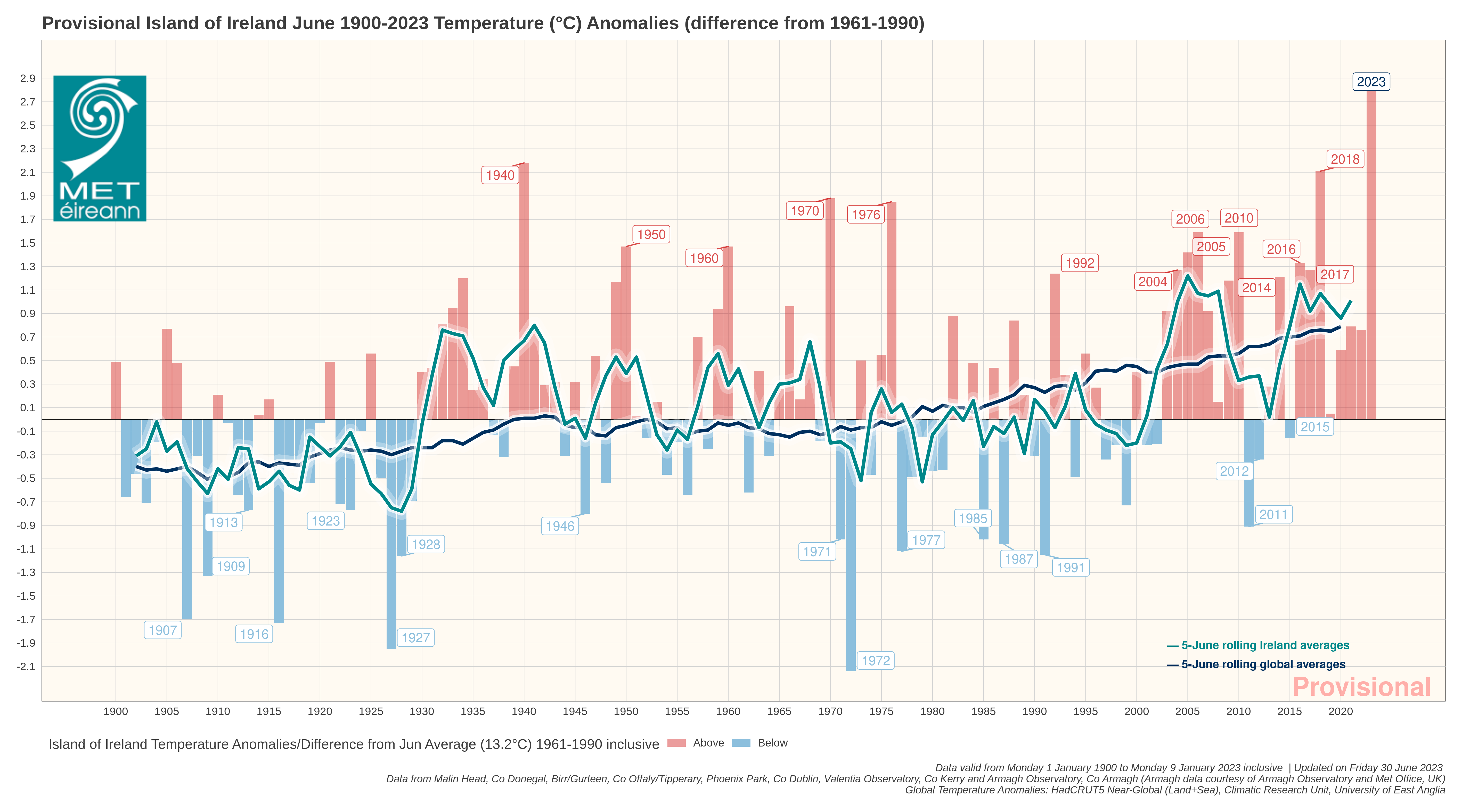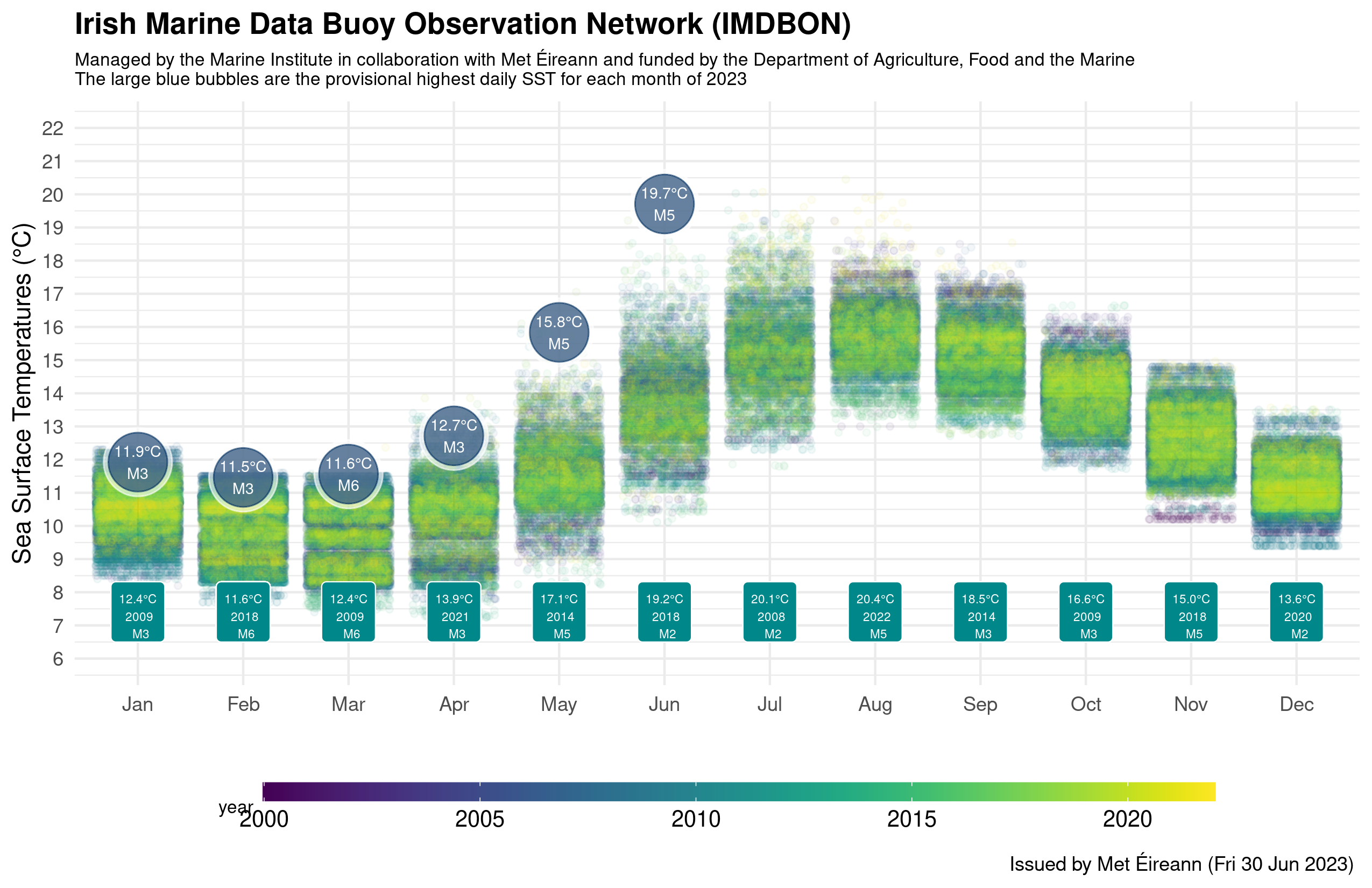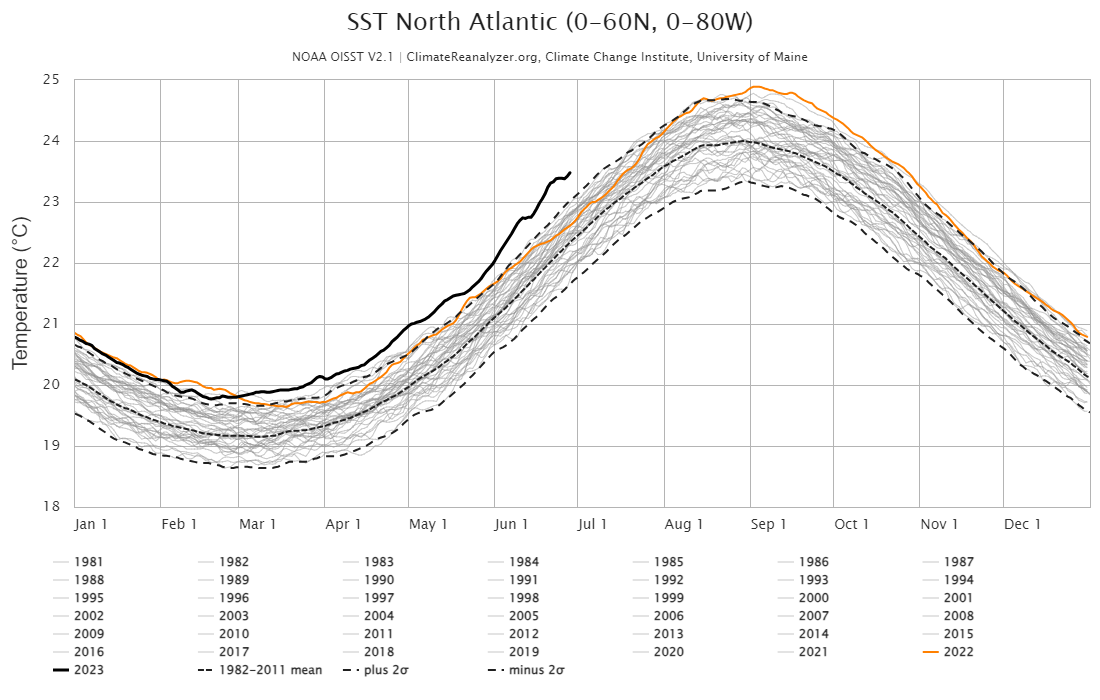Issued Friday 30 June 2023
Provisional data suggests that June 2023 will be:
- The warmest June on record for Ireland, on both land and at sea.
- Breaking the previous warmest June of 1940, that is 83 years ago.
- It is also expected that the June average for 2023 will be >16°C for the first time for June. This average value has been observed occasionally in July and August.
- At individual stations, we also know that 23 of 25 of the primary weather stations have had their warmest June on record.
- The Marine area is experiencing unusually warm temperatures also, with the warmest June sea surface temperature on record here also.
June 2023 provisionally warmest June on record for Ireland
The average June temperature is expected to be over 16.0 °C, which will be greater than half a degree above the previous warmest June in 1940. It is 83 years since the warmest June on record for Ireland which occurred in June 1940 and 51 years since the coldest June on record for Ireland which occurred in June 1972. The dataset used for this analysis is 124 years long, that is from and including the year 1900.

The above graph illustrates the temperature anomalies (average June temperature for each year as a difference from the 1961-1990 June average)
Met Éireann climatologist Dr Sandra Spillane said: “This June will be provisionally the hottest June on record for Ireland and we are likely to have our first 16+°C average June temperature ever, being head and shoulders above all other June averages.” An average monthly temperature of greater than 16 degrees has been seen occasionally in July or August.
- June 2023 was the 8th consecutive June above normal, as June 2015 was below normal for June.
- June 2023 was also the 6th consecutive month above normal, as December 2022 was below normal.
- Of the top ten warmest Junes on record half that have occurred since 2005, that is (in order of warmest) 2023, 2018, 2010, 2006 and 2005.
- June’s average temperature has warmed by 1°C since 1900.
Met Éireann Head of Climate Services Keith Lambkin says “This year’s particularly warm June is part of an observed warming trend, a trend that the latest climate change models for Ireland suggest will continue, a trend that we must adapt to”.
As you will see in the following table, and in this 124-year long dataset, half of the warmest months have occurred since 2008:
| JAN | FEB | MAR | APR | MAY | JUN | JUL | AUG | SEP | OCT | NOV | DEC |
| 1916 | 1998 | 1957 | 2011 | 2008 | 2023 | 2013 | 1995 | 2021 | 1969 | 1994 | 2015 |
The reason why June 2023 is well above normal is due to persistent warm days and nights. Further analysis of temperatures at the primary weather stations around Ireland show that:
- Athenry, Co Galway and Shannon Airport, Co Clare have experienced 27 consecutive days with maximum air temperatures > 20.0 °C, ending on Saturday 24 June 2023. Summer 1995 observed 36 consecutive days at various stations in Leinster, ending on Saturday 26 August 1995.
- Newport, Co Mayo experienced 5 consecutive nights where air temperatures did not fall below 15.5 °C, ending on Wednesday 14 June 2023.
- June’s highest air temperature was 28.8°C reported at Oak Park, Co Carlow (10.5°C from its LTA) on Tuesday 13th. For the first time in Ireland’s climate record, temperature at or above this value has been observed for the 3rd consecutive year in any month and at any station.
Met Éireann climatologist Paul Moore said “Twenty-three of twenty-five synoptic stations are having their warmest June on record. Only Phoenix Park and Dublin Airport are having their warmest June since 1976. Likely because in early June there were cool easterly winds on the east coast.”
Paul continues “The synoptic scale patterns, which led to June 2023 being the warmest on record, began with a blocking area of high pressure just to the north of Ireland giving almost unbroken sunshine in a slack easterly airflow. By mid-month an unstable, warm and humid air mass became established over the country from the south, culminating in eight consecutive days of intense thunderstorm activity between 13th and 20th. This setup, along with weak steering currents, led to sea surface temperatures around our coasts reaching record high levels for June, which in turn created a feedback loop, helping to maintain the above average temperatures over land until the end of the month. ”
More to be published on the provisional statement of June 2023’s past weather and climate will be published morning of Tuesday 4 July 2023, this will also include rainfall and sunshine at the various SYNOPTIC stations. Keep an eye on https://www.met.ie/about-us/latest-news for more.
Sea Surface Temperatures (°C)
The Irish Marine Data Buoy Observation Network (IMDBON) is managed by the Marine Institute in collaboration with Met Éireann and funded by the Department of Agriculture, Food and the Marine.IMDBON has been measuring sea surface temperature (SST) at 5 sites around Ireland for over 20 years.
Met Éireann marine meteorologist Méabh Nic Guidhir says “June 2023 is provisionally the warmest on record for Irish seas. Data suggests that sea surface temperature at each buoy was warmer by at least 0.4°C from their respective previous warmest Junes.” Seas around Ireland experienced a marine heatwave during June, with temperatures peaking around the 20-22nd of the month. This heatwave resulted in mean SST values which are provisionally 1.8 – 2.5°C above the June average for each location. In addition, all IMDBON buoys broke their previous records for maximum June SST.
- The highest June daily sea surface temperature (SST) of 19.7°C was observed at Buoy M5. This observation is 0.5 °C above the previous highest June SST observed at Buoy M2 in June 2018.
- June is typically a month with a large range of sea surface temperatures, ranging from 10 to 19 degrees.
- All buoys individually broke their maximum daily sea surface record this year:
| Buoy | Location | June 2023 Max SST (°C) | June Max SST pre-2023 (°C) |
| M2 | Irish Sea | 17.9 | 16.1 |
| M3 | Off Cork | 19.0 | 18.6 |
| M4 | Off Donegal | 18.3 | 16.6 |
| M5 | Off South Wexford | 19.7 | 19.2 |
| M6 | Deep Atlantic | 17.6 | 16.4 |

The above graph illustrates sea surface temperatures at the IMDBON buoys around Ireland. Where daily observations distributed in a box plot and extremes are highlighted.
Climate of Europe and the World for June 2023
Met Éireann’s researcher Dr Pádraig Flattery says that climate change impacts are evident across Europe. The rate of June heatwaves has tripled in Spain in the past 12 years, and June temperatures reached 44°C in Seville and Cordoba. The World Meteorological Organisation recently warned that Europe is warming twice as fast as other continents, that 16,000 people died as a result of extreme heat last year, and widespread droughts caused significant economic impacts. Both Ireland and the United Kingdom have had their warmest June in 2023 since 1940.
Global sea-surface temperatures in 2023 have been the highest ever recorded for April, May and June, and continue to persist well above the previous highest temperature. The ocean’s record-breaking heat is a result of a combination of human-caused climate change and natural climate variations. Climate change, fueled by greenhouse gas emissions from human activities, is steadily warming the planet’s surface, including the oceans. The oceans absorb 90% of this excess heat, and this warming has consequences for marine ecosystems and habitats, and can cause coral bleaching and reductions in fish stocks.
Met Éireann climatologist Paul Moore states: “We are seeing sea surface temperatures around what we would get in August rather than June. The whole North Atlantic on our side is quite a bit above average in places.”
For more information, see www.met.ie/marine-heat-wave-2023-a-warning-for-the-future.

The graph illustrates 2023 (dark black line) Global Sea-Surface Temperatures in context (NOAA – ClimateReanalyzer.org)
Media enquiries: media@met.ie
Climate enquiries: enquiries@met.ie